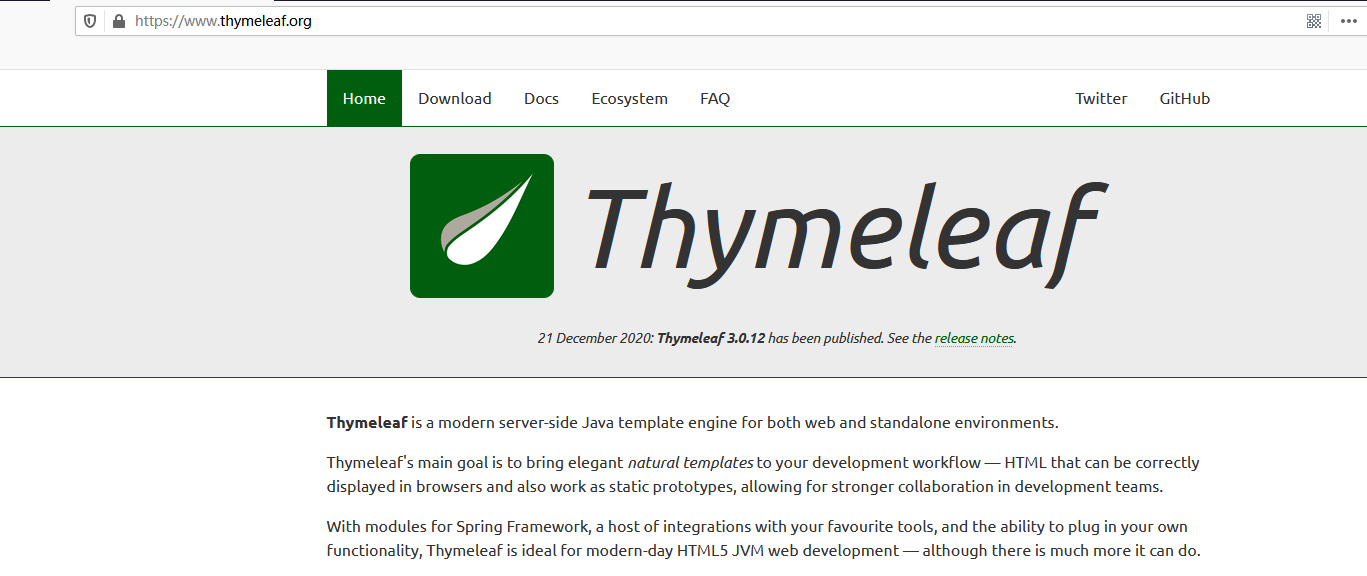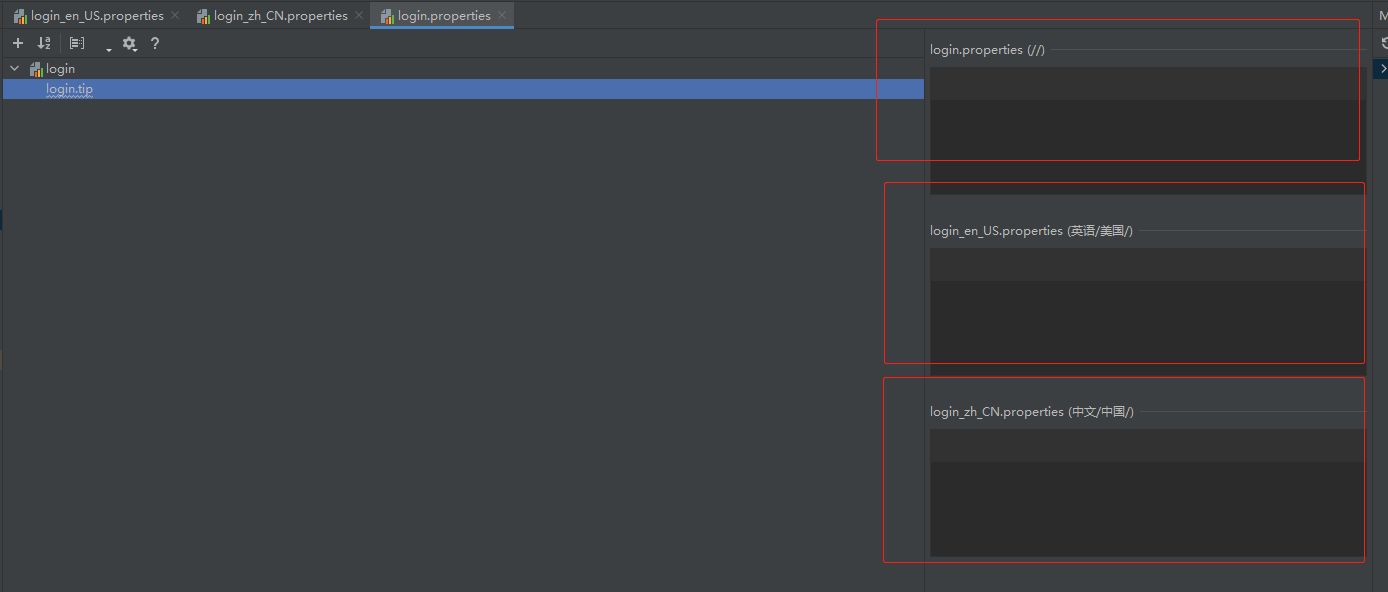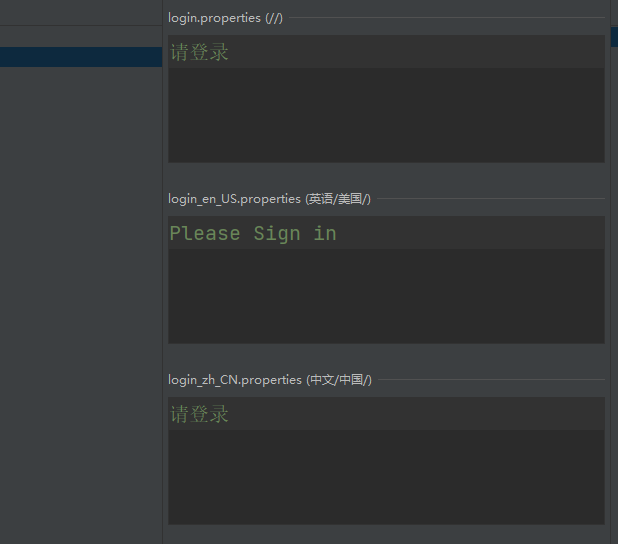SpringBoot学习笔记(六)
本文主要介绍SpringBoot:Thymeleaf模板引擎和国际化的使用
一、SpringBoot:Thymeleaf模板引擎
在学习Thymeleaf之前,我们回忆一下JSP:
JSP(全称JavaServer Pages)是由Sun Microsystems公司主导创建的一种动态网页技术标准。JSP部署于网络服务器上,可以响应客户端发送的请求,并根据请求内容动态地生成HTML、XML或其他格式文档的Web网页,然后返回给请求者。JSP技术以Java语言作为脚本语言,为用户的HTTP请求提供服务,并能与服务器上的其它Java程序共同处理复杂的业务需求。----摘自百度百科
JSP最大的特点,是支持Java开发,能以模板话的方式,动态添加动态网页内容,轻松实现数据显示与交互。
然而,SpringBoot项目以jar的形式发布,而且内嵌Tomcat,它默认是不支持JSP的。
- SpringBoot推荐使用模板引擎:
其实jsp就是一个模板引擎,还有用的比较多的freemarker,包括SpringBoot给我们推荐的Thymeleaf。

在知乎上,有很多大神解答:Spring / SpringBoot为什么推荐使用thymeleaf?

- 众多模板引擎,其实它们的思想都是大同小异:

模板引擎重要的是交互数据,能够动态的将页面数据展示,后台分装的数据要如何与前端的所需要的数据对应起来,模板引擎在中间起到定位传递数据的效果。
- 介绍SpringBoot如何使用Thmeleaf
Thymeleaf 官网:https://www.thymeleaf.org/
Thymeleaf 在Github 的主页:https://github.com/thymeleaf/thymeleaf
1.引入Thymeleaf
在Spring官方文档中,可以找到Guies:Learn how to create a web page with Spring MVC and Thymeleaf.

在SpringBoot文档可以找到Thymeleaf的Starter:https://docs.spring.io/spring-boot/docs/2.4.4/reference/html/using-spring-boot.html#using-boot-starter

找到对应的pom依赖:
<!--Thymeleaf-->
<dependency>
<groupId>org.springframework.boot</groupId>
<artifactId>spring-boot-starter-thymeleaf</artifactId>
</dependency>
Maven会自动下载jar包:

- 引入完毕,如何使用:
首先得按照SpringBoot的自动配置原理看一下我们这个Thymeleaf的自动配置规则,在按照那个规则,我们进行使用。
我们去找一下Thymeleaf的自动配置类:ThymeleafProperties (看到其默认的前缀/后缀)

使用Thymeleaf什么都不需要配置,我们将文件放到指定的文件夹下即可,Thymeleaf会帮助我们自动渲染。非常符合开箱即用的原则,而且在无网络的状态下,依然可以使用,代码风格优雅,简洁。
- 测试
1.编写一个TestController
import org.springframework.stereotype.Controller;
import org.springframework.web.bind.annotation.RequestMapping;
@Controller
public class TestController {
@RequestMapping("/test")
public String test1(){
//classpath:/templates/test.html
return "test";
}
}
2、编写一个测试页面 test.html 放在 templates 目录下
<!DOCTYPE html>
<html lang="en">
<head>
<meta charset="UTF-8">
<title>Title</title>
</head>
<body>
<span style="background: orange">Hello,Thymeleaf!</span>
</body>
</html>
3.Run

- Thymeleaf 语法学习
Thymeleaf 官网:https://www.thymeleaf.org/
- 做个简单的练习 :需求查出一些数据,并在页面中展示。
1、修改测试请求,增加数据传输

@RequestMapping("test2")
public String test2(Model model){
//存入数据
String name="I love China";
model.addAttribute("msg",name);
return "test2";
}
2、要使用thymeleaf,需要在html文件中导入命名空间的约束,方便提示。
xmlns:th="http://www.thymeleaf.org"
3.编写前端页面
<!DOCTYPE html>
<html lang="en" xmlns:th="http://www.thymeleaf.org">
<head>
<meta charset="UTF-8">
<title>你来啦</title>
</head>
<body>
<h4>注意:要使用thymeleaf,需要在html文件中导入命名空间的约束,方便提示!</h4>
<h2 th:text="${msg}"></h2>
</body>
</html>
4.Run

- Thymeleaf的使用语法:
- 文档需要自己看,下面再来个小测试:
1.Controller,放一些数据
@RequestMapping("/test3")
public String test3(Map<String,Object> map){
map.put("msg","<h1>Hello</h1>");
map.put("users", Arrays.asList("zhouzhou",new Date()));
return "test3";
}
2.测试页面取出数据:
<!DOCTYPE html>
<html lang="en" xmlns:th="http://www.thymeleaf.org">
<head>
<meta charset="UTF-8">
<title>My Thymeleaf</title>
</head>
<body>
<h1>多看文档,了解更多Thymeleaf的使用</h1>
<br/>
<h2>用th:text不会解析html,用th:utext会解析html,在页面中显示相应的样式</h2>
<div th:text="${msg}"></div>
<div th:utext="${msg}"></div>
==================分割线===============================
<!--遍历数据-->
<h4 th:each="user:${users}" th:text="${user}"></h4>
<h4>
<!--行内写法-->
<span th:each="user:${users}">[[${user}]]</span>
</h4>
</body>
</html>
3.Run

二、SpringBoot:国际化
有些网站会去涉及中英文甚至多语言的切换——国际化
- 准备工作
先在IDEA中统一设置properties的编码问题:

- 编写国际化配置文件
1.在resources资源文件下新建一个i18n目录,存放国际化配置文件
2.建立一个login.properties文件、login_zh_CN.properties文件,发现IDEA自动识别了我们要做国际化操作。
文件夹变了!

3.利用这里,再新建一个文件

显示:

4.编写配置也可以用视图:

5.在视图中,点击 + 号就可以直接添加属性

6.新建一个login.tip,可以看到边上有三个文件框可以输入

7.添加内容

8.抽取页面需要显示的国际化页面消息,找到哪些内容需要编写国际化的配置

找到配置文件并查看:

配置文件部分搞定!
9.由于我们添置了i18n目录,所以我们要去配置这个messages的路径:

spring.messages.basename=i18n.login
- 配置文件生效探究
看一下SpringBoot对国际化的自动配置!这里又涉及到一个类:MessageSourceAutoConfiguration
/**
* {@link EnableAutoConfiguration Auto-configuration} for {@link MessageSource}.
*
* @author Dave Syer
* @author Phillip Webb
* @author Eddú Meléndez
* @since 1.5.0
*/
@Configuration(proxyBeanMethods = false)
@ConditionalOnMissingBean(name = AbstractApplicationContext.MESSAGE_SOURCE_BEAN_NAME, search = SearchStrategy.CURRENT)
@AutoConfigureOrder(Ordered.HIGHEST_PRECEDENCE)
@Conditional(ResourceBundleCondition.class)
@EnableConfigurationProperties
public class MessageSourceAutoConfiguration {
private static final Resource[] NO_RESOURCES = {};
@Bean
@ConfigurationProperties(prefix = "spring.messages")
public MessageSourceProperties messageSourceProperties() {
return new MessageSourceProperties();
}
//获取properties 传递过来的值,进行判断
@Bean
public MessageSource messageSource(MessageSourceProperties properties) {
ResourceBundleMessageSource messageSource = new ResourceBundleMessageSource();
// 设置国际化文件的基础名(去掉语言国家代码的)
if (StringUtils.hasText(properties.getBasename())) {
messageSource.setBasenames(StringUtils
.commaDelimitedListToStringArray(StringUtils.trimAllWhitespace(properties.getBasename())));
}
if (properties.getEncoding() != null) {
messageSource.setDefaultEncoding(properties.getEncoding().name());
}
messageSource.setFallbackToSystemLocale(properties.isFallbackToSystemLocale());
Duration cacheDuration = properties.getCacheDuration();
if (cacheDuration != null) {
messageSource.setCacheMillis(cacheDuration.toMillis());
}
messageSource.setAlwaysUseMessageFormat(properties.isAlwaysUseMessageFormat());
messageSource.setUseCodeAsDefaultMessage(properties.isUseCodeAsDefaultMessage());
return messageSource;
}
//省略下面代码
- 测试1:设计一个简单的页面
<!DOCTYPE html>
<html lang="en" xmlns:th="http://www.thymeleaf.org">
<head>
<meta charset="UTF-8">
<title>Title</title>
</head>
<body>
<form action="/test">
<h3 th:text="#{login.tip}">Please Sign in</h3>
<input type="text" th:placeholder="#{login.username}">
<input type="password" th:placeholder="#{login.password}">
<a>中文</a>
<a>English</a>
</form>
</body>
</html>
Run: 启动项目,访问一下,发现已经自动识别为中文。

- 测试2:实现根据按钮自动切换中文英文
配置国际化解析
在Spring中有一个国际化的Locale (区域信息对象);里面有一个叫做LocaleResolver (获取区域信息对象)的解析器。
我们去webmvc自动配置文件,寻找SpringBoot默认配置:

其中,FIXED常量源码:

另外查看到,AcceptHeaderLocaleResolver这个类中有一个方法:

所以,想让我们的国际化资源生效,就需要让我们自己的Locale生效!我们写一个自己的LocaleResolver,可以在链接上携带区域信息!
1.修改一下前端页面的跳转连接:
<!DOCTYPE html>
<html lang="en" xmlns:th="http://www.thymeleaf.org">
<head>
<meta charset="UTF-8">
<title>Title</title>
</head>
<body>
<form action="/test">
<h3 th:text="#{login.tip}">Please Sign in</h3>
<input type="text" th:placeholder="#{login.username}">
<input type="password" th:placeholder="#{login.password}">
<!-- 这里传入参数不需要使用问号(?),使用(key=value)-->
<a th:href="@{/test4(language='zh_CN')}">中文</a>
<a th:href="@{/test4(language='en_US')}">English</a>
</form>
</body>
</html>
2.添加组件(处理国际化需求)
package com.zhou.component;
import org.springframework.util.ObjectUtils;
import org.springframework.web.servlet.LocaleResolver;
import javax.servlet.http.HttpServletRequest;
import javax.servlet.http.HttpServletResponse;
import java.util.Locale;
public class MyLocaleResolver implements LocaleResolver {
//解析请求
@Override
public Locale resolveLocale(HttpServletRequest httpServletRequest) {
String language = httpServletRequest.getParameter("language");
Locale aDefault = Locale.getDefault();//如果没有获取到就是用系统默认的
//如果请求连接不为空:StringUtils.isEmpty(language)被弃用了。
if(!ObjectUtils.isEmpty(language)){
//分割请求参数
String[] split = language.split("_");
//国家,地区
aDefault = new Locale(split[0], split[1]);
}
return aDefault;
}
@Override
public void setLocale(HttpServletRequest httpServletRequest, HttpServletResponse httpServletResponse, Locale locale) {
}
}
3.配置组件
package com.zhou.config;
import com.zhou.component.MyLocaleResolver;
import org.springframework.context.annotation.Bean;
import org.springframework.context.annotation.Configuration;
import org.springframework.web.servlet.LocaleResolver;
import org.springframework.web.servlet.config.annotation.WebMvcConfigurer;
//扩展SpringBoot
@Configuration
public class MyMvcConfig implements WebMvcConfigurer {
//自定义国际化组件生效
@Bean
public LocaleResolver localeResolver(){
return new MyLocaleResolver();
}
}
4.测试:
访问:http://localhost:8084/test4 并点击:中文 或者English
点击中文:

点击English




【推荐】国内首个AI IDE,深度理解中文开发场景,立即下载体验Trae
【推荐】编程新体验,更懂你的AI,立即体验豆包MarsCode编程助手
【推荐】抖音旗下AI助手豆包,你的智能百科全书,全免费不限次数
【推荐】轻量又高性能的 SSH 工具 IShell:AI 加持,快人一步
· 基于Microsoft.Extensions.AI核心库实现RAG应用
· Linux系列:如何用heaptrack跟踪.NET程序的非托管内存泄露
· 开发者必知的日志记录最佳实践
· SQL Server 2025 AI相关能力初探
· Linux系列:如何用 C#调用 C方法造成内存泄露
· 震惊!C++程序真的从main开始吗?99%的程序员都答错了
· 【硬核科普】Trae如何「偷看」你的代码?零基础破解AI编程运行原理
· 单元测试从入门到精通
· 上周热点回顾(3.3-3.9)
· Vue3状态管理终极指南:Pinia保姆级教程